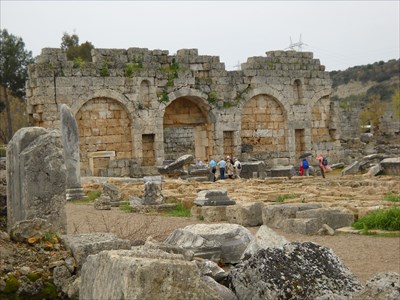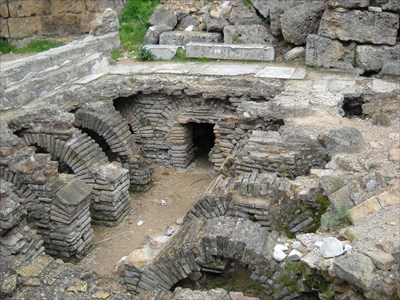
Agora de Smyrne - Izmir, Turkey
Posted by:  pmaupin
pmaupin
N 38° 25.131 E 027° 08.252
35S E 512006 N 4252297
[EN] Central market of the city, the agora was built IVth century before J.C. [FR] Marché central de la ville, l’agora fut construite IVème siècle avant J.C. [T] Kentin merkezi pazarinda, IV. Yüzyilda kurulan agora J.C.
Waymark Code: WMWWEK
Location: Türkiye
Date Posted: 10/22/2017
Views: 4

 Surrounded by modern buildings, the Izmir agora seems to emerge in the middle of the contemporary city as the vestige of a bygone era that would suddenly rise to the surface.
Surrounded by modern buildings, the Izmir agora seems to emerge in the middle of the contemporary city as the vestige of a bygone era that would suddenly rise to the surface.
Its Corinthian columns and capitals rise proudly before our eyes, seeming to shine under the sun. Central market of the city, the agora was built IVth century before J.C.
Destroyed by an earthquake in 178 BC, most of the ruins of the agora that we see today date from its reconstruction under the Emperor Marcus Aurelius.
Rectangular in shape, the agora houses a large courtyard surrounded by galleries of columns. In this courtyard were built monuments in honor of important people and dates, statues, altars dedicated to the various deities for religious ceremonies etc.
The northern part of the agora later served as a basilica, part of whose foundations have survived to this day. It is a beautiful example of basilicas in Roman times that has survived.
The western part of the agora consists of galleries of columns covers a structure with two floors: the ground floor and a second floor where people could in case of need to protect themselves from the rain, the sun, to walk, to exchange goods etc.
The blinding brilliance of the stones and the sun would make us almost miss the Empress Faustine's face engraved in the stone seven meters above our heads.
An avenue of the city intersected with the agora. The door that stands today in front of us and where we can see the inlaid face of Faustine, wife of Marcus Aurelius, marked this intersection.
Sources : The Agora


 Entourée de bâtiments modernes, l’agora d’Izmir semble émerger au milieu de la ville contemporaine comme le vestige d’un temps révolu qui serait subitement remonté à la surface.
Entourée de bâtiments modernes, l’agora d’Izmir semble émerger au milieu de la ville contemporaine comme le vestige d’un temps révolu qui serait subitement remonté à la surface.
Ses colonnes corinthienne et chapiteaux se dressent fièrement devant nos yeux, semblant rayonner sous le soleil. Marché central de la ville, l’agora fut construite IVème siècle avant J.C.
Détruite par un tremblement de terre en 178 avant J.C., la plupart des ruines de l’agora que l’on voit aujourd’hui datent de sa reconstruction sous l’empereur Marc Aurèle.
De forme rectangulaire, l’agora abrite une large cour entourée de galeries de colonnes. Etaient érigés dans cette cour des monuments en l’honneur de personnes et de dates importantes, des statues, des autels dédiés aux diverses divinités pour les cérémonies religieuses etc.
La partie nord de l’agora servit par la suite de basilique dont une partie des fondations ont survécu jusqu’à nos jours. Elle est un bel exemple de basiliques à l’époque romaine qui nous soit parvenu.
La partie ouest de l’agora composée de galeries de colonnes recouvre une structure à deux étages : le rez-de-chaussée et un second étage où les gens pouvaient en cas de besoin se protéger de la pluie, du soleil, se promener, échanger des biens etc.
L’éclat aveuglant des pierres et du soleil nous ferait presque passer à côté du visage de l’impératrice Faustine gravé dans la pierre sept mètres au dessus de nos têtes.
Une avenue de la ville entrait en intersection avec l’agora. La porte qui se dresse aujourd’hui devant nous et où l’on peut voir le visage incrusté de Faustine, épouse de Marc Aurèle, marquait cette intersection.
Sources : L’Agora


 Modern binalarla çevrili Izmir agorasi çagdas sehrin ortasinda aniden yüzeye çikacak geçmis bir dönemin kalintisi olarak ortaya çikiyor gibi görünüyor.
Modern binalarla çevrili Izmir agorasi çagdas sehrin ortasinda aniden yüzeye çikacak geçmis bir dönemin kalintisi olarak ortaya çikiyor gibi görünüyor.
Korinth sütunlari ve baskentleri günesin altinda parliyor gibi gözlerimizin önünde gururla yükseliyor. Kentin merkezi pazarinda, IV. Yüzyilda kurulan agora J.C.
M.Ö. 178'de meydana gelen bir depremle yikilarak bugün görülen agoranin kalintilari, Imparator Marcus Aurelius'un yeniden insasindan kaynaklaniyor.
Dikdörtgen seklinde olan agora, galeri galerileri ile çevrili genis bir avlu barindirmaktadir. Bu avluda önemli insanlar, tarihi, heykelleri, dini törenler için çesitli tanrilara adanmis sunaklari onurlandiran anitlar yapilmistir.
Agoranin kuzey kismi daha sonra temellerinin bir kismi günümüze ulasan bir bazilika görev yapmistir. Roma çaglarinda ayakta kalan bazilikalarin güzel bir örnegidir.
Agoranin bati kismi sütunlardan olusan galeri, iki katli bir yapi kaplar: zemin kat ve insanlarin yagmurdan, günesten, yürümekten, alisveris yapmaktan kendilerini korumak isteyebilecekleri ikinci bir kat. mal vs.
Taslarin ve günesin kör edici parlakligi, Imparatoriçe Faustin'in kafamizin yedi metre yüksekligindeki tas oymaciliginin yüzünü neredeyse özlese- bilir.
Sehrin bir caddesi agora ile kesisir. Bugün önümüzde duran kapi ve Marcus Aurelius'un karisi Faustine'in kakma yüzünü burada görebildigimiz bu kavsagi isaretledik.
Sources : L‘Agora